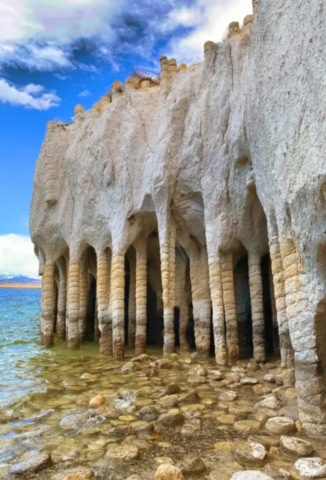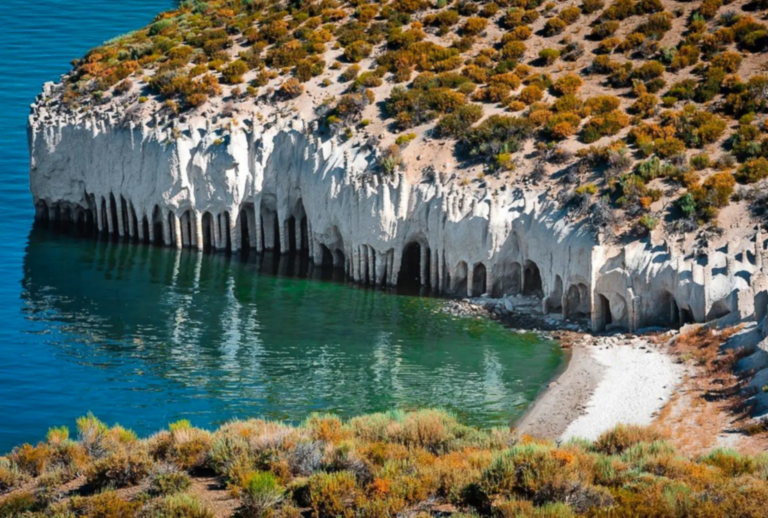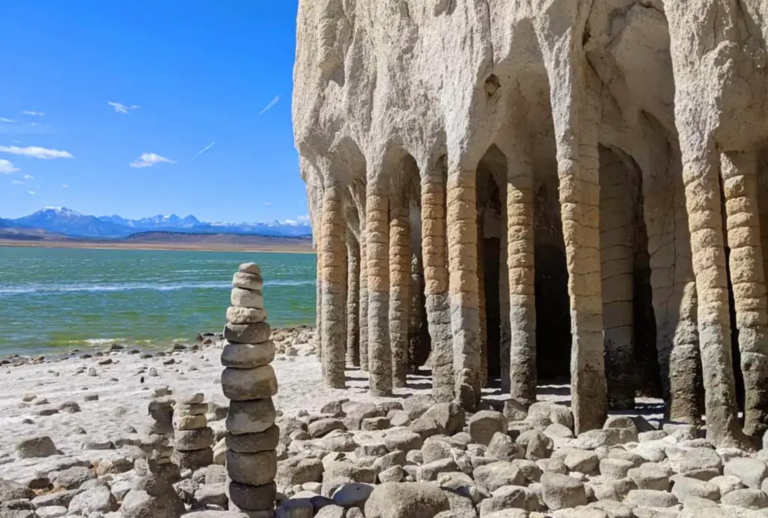The mystery of the Crowley Lake columns, California
The Crowley Lake Columns, located in California, are a unique geological formation that intrigues scientists and geology enthusiasts. Reaching up to 6 meters high and often connected by arches, these columns are reminiscent of ancient temple architecture. Long hidden beneath layers of volcanic ash, they were gradually exposed by erosion from the Crowley Reservoir, created in 1941.
The reservoir was built as part of the Los Angeles Water Management System to store water from the Owens River and meet the city's growing water needs. This project, although fraught with environmental controversy, contributed to the discovery and gradual exposure of the columns through wave action eroding the volcanic tuff cliffs.
The site, located approximately 16 kilometers south of Mammoth Lakes, is accessible via off-road trails or by boat. Hiking remains an option for visitors wishing to admire these exceptional formations up close. Today, they are the subject of in-depth studies to understand their formation process and their volcanological significance.
Geological context :
The formation of the columns is directly linked to the cataclysmic eruption that created the Long Valley Caldera approximately 760,000 years ago. This event, 2,000 times more powerful than the 1980 eruption of Mount St. Helens, covered the region with a thick layer of silica-rich volcanic ash. This layer was exposed to hydrothermal events that altered its internal structure and led to the formation of the columns we see today.
Formation mechanism :
According to research conducted at the University of California, Berkeley, by Noah Randolph-Flagg and his team, the Crowley Lake columns are the result of a natural thermal convection phenomenon. When water from melting snow or precipitation seeped into the still-hot ash, it was heated to a boil and rose as steam. This phenomenon generated regularly spaced convection cells, promoting the precipitation of minerals that cement the tuff into erosion-resistant structures.
X-ray diffraction and electron microscopy analyses revealed that the interstitial spaces of the columns are cemented by resistant minerals, such as mordenite (a zeolite), as well as deposits of amorphous silica and iron hydroxide. This crystallization strengthened the columns, explaining why they resisted erosion, which, in turn, destroyed the surrounding, more brittle tuff.
The regular arrangement of the columns is due to heterogeneous cooling of the tuff. Depending on the density of convection cells and local temperature gradients, variations in the size and spacing of the columns are observed.
Physical characteristics and arrangement of columns :
It is estimated that nearly 5,000 columns exist within an area of 5 to 8 square kilometers east of Crowley Lake. They come in various shapes and sizes : some are straight like telephone poles, with horizontal cracks spaced about 30 cm apart, while others are curved or inclined in the same direction. Some have a grayish tint, while others display reddish-orange hues, suggesting chemical and thermal variations during their formation.
Further analysis would allow for detailed study of the rate of column formation, the exact composition of the precipitated minerals, and the environmental conditions that influenced their morphology. Studying these columns provides a better understanding of post-eruption hydrothermal conditions as well as the rapid solidification processes of volcanic ash. They offer insight into the evolution of the local climate and environment following a major eruption.
Conclusion
The Crowley Lake Columns site is increasingly recognized as a significant natural and scientific heritage site. The Los Angeles Department of Water and Power has implemented educational programs to raise public awareness about the formation and preservation of these structures. At the same time, mapping studies and geochemical analyses are being conducted to document their precise distribution and composition. These geological objects represent a fascinating example of the complex interactions between water, heat, and minerals within an ancient volcanic system. Their study continues to provide valuable information on the dynamics of hydrothermal reservoirs and the geological history of the Long Valley Caldera. Promoting the site through educational and scientific initiatives will help raise public awareness of the richness of these natural geological formations.
References :
RANDOLPH-FLAGG, N., RIGBY, J. K., & CODY, A. D. (2017). Evenly spaced columns in the Bishop Tuff (California, USA) as relicts of hydrothermal cooling. Geology, 45(11), 999-1002.



